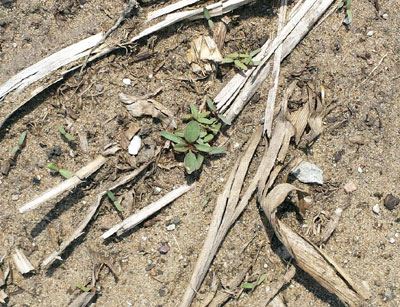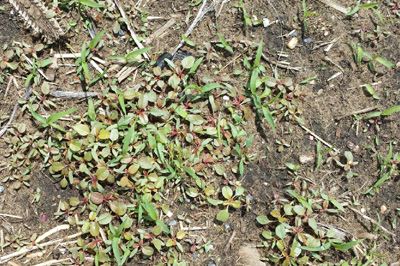It’s Not Too Early To Scout For Palmer Amaranth
DR. AARON HAGER
URBANA, ILL.
Planting progress may have been slowed by the recent precipitation,
but weed emergence continues despite wet field conditions. Be aware that
Palmer amaranth has begun to emerge. We scouted our Palmer amaranth
field location west of Kankakee on May 8 and observed emerged Palmer
amaranth plants (Figure 1).

Figure 1. Emerged Palmer amaranth, May 8 near Kankakee
We returned to the field on May 15 to find a very robust Palmer
amaranth population (Figure 2). The largest Palmer amaranth plants found
on May 15 were approximately 2 inches tall with 6 to 8 true leaves.

Figure 2. Emerged Palmer amaranth, May 15 near Kankakee
Some leaf petioles on older Palmer amaranth plants already had
elongated to approximately twice the length of the leaf blade, but we
did not find any leaves with chevrons or watermarks. Extension weed
scientists in Iowa and Ohio also have reported finding emerged Palmer
amaranth plants in their respective states.
Completing corn and soybean planting will assume top priority when
field conditions are again suitable, but please do not overlook the need
to control emerged Palmer amaranth in fields already planted. The
return of warm air temperatures coupled with ample soil moisture will
help emerged Palmer amaranth plants grow very rapidly. Postemergence
herbicides should be applied before Palmer amaranth plants are taller
than 4 inches. It is NOT advisable to delay the application of
postemergence herbicides until additional Palmer amaranth plants
emerge. Delayed application of postemergence herbicides, whether by
choice or due to adverse weather conditions, can lead to disastrous
outcomes.
Palmer amaranth continues to germinate throughout much of the growing
season, making it altogether likely that additional Palmer amaranth
plants will emerge following the initial postemergence herbicide
application. Consider including a soil-residual herbicide with the
postemergence herbicide to control additional Palmer amaranth emergence
and allow the crop to gain a competitive advantage over later-emerging
weeds. ∆
DR. AARON HAGER: Associate Professor, University of Illinois